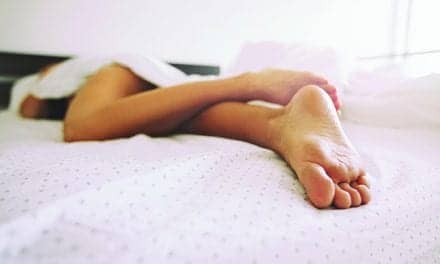People who have moderate to severe restless legs syndrome (RLS) are four times as likely to experience clinically severe depression and suicidal thoughts as the general population, according to a new study by the RLS Foundation. Despite patients’ symptom severity, primary care physicians frequently misdiagnose or mistreat the condition, the research also found.
The RLS Foundation study, called ODYSSEY II, also notes people with moderate to severe RLS have less than half the health-related quality of life (HRQoL) of a fully healthy person. This is comparable to the reduced quality of life from conditions such as psoriasis, chronic obstructive pulmonary disease (COPD), overactive bladder, and inflammatory bowel disease.
“This study underscores the toll that RLS has on mental and physical health,” says Charles E. Phelps, PhD, a health economist and senior author of the study, in a release. “Depression and suicidal thoughts are major consequences of RLS, in addition to sleep loss. Sleep deprivation caused by RLS can rob people of the ability to live and work normally. Sleep loss also puts people at increased risk of developing hypertension, diabetes, heart attack, stroke, and Alzheimer’s disease.”
An estimated 7%–8% of adults in the US have RLS, and 2%–3% need ongoing treatment. There are four FDA-approved drugs to treat RLS.
In ODYSSEY II, 2,745 people with confirmed RLS completed a survey about RLS diagnosis and severity, associated medical conditions, treatments, and medical care.
Among the respondents, 37% had depression that was moderate or worse—a rate four times that of the general US adult population. In addition, 15% had suicidal thoughts—four times the national average. By mapping depression scores to a standard measure for health-related quality of life, the researchers found that ODYSSEY II participants experienced less than half the quality of life of a fully healthy person.
The survey also found delays in diagnosis and treatment. Overall, the average time from when people first began experiencing bothersome RLS symptoms to seeking treatment was 9.8 years, and from there the average time to diagnosis was 2.2 years.
Almost half of confirmed RLS patients (43%) reported that their primary care providers did not take their condition seriously. Those who received treatment at certified RLS Quality Care Centers rated their providers favorably 80% of the time, compared with only 52% of those using non-certified providers. Further, among patients taking opioid medication for RLS, 21% reported difficulty obtaining prescription renewals.
“These findings point to the urgent need for universal screening for RLS in primary care and for provider education,” says Phelps. “People are suffering needlessly with RLS for a decade or more before they receive treatment.”
Results also show limitations in RLS treatment options. Many respondents had stopped taking medications due to side effects or lack of relief. This emphasizes the need for further basic and clinical research to improve RLS treatment options and find a cure.
A companion survey was completed by 432 people living with partners who had RLS. Results show RLS impacts partners in areas such as sleep, social lives, travel, mood, and happiness. About one-third of partners had moved into separate beds, and almost 1 in 20 said that their partners’ RLS was disruptive enough to consider ending the relationship.
Karla Dzienkowski, executive director of the RLS Foundation, says in a release, “ODYSSEY II highlights the challenges that people with RLS are facing every day. We need to shorten the diagnostic timeline and improve RLS medical care. And we need research to find more enduring treatments for the millions of people who struggle with this devastating disease.”
ODYSSEY II was supported by an educational grant from Azurity Pharmaceuticals, marketers of the RLS drug Horizant.




